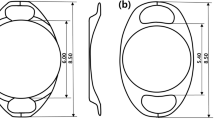Abstract
Background
To evaluate the safety and efficacy of implanting a secondary IOL in comparison with IOL exchange to correct residual spherical refractive error after cataract surgery.
Method
This prospective case series included 23 pseudophakic eyes of 23 patients. They were divided into two groups: group I included 12 eyes for whom secondary piggyback IOL implantation in the ciliary sulcus was done, and group II included 11 eyes for whom IOL exchange was done. The mean follow up was 18 ± 4.2 months and 20 ± 3.6 months in groups I and II respectively. The visual and refractive outcomes were evaluated, and any intraoperative or postoperative complications was recorded.
Results
The mean spherical equivalent in group I (secondary piggyback implantation), was reduced from −6.2 ± 2.2 diopters preoperatively to −0.28 ± 0.59D postoperatively in myopic eyes and from 4.79 ± 1.02D to 0.03 ± 0.74D in hyperopic eyes. Ninety-two percent of eyes were within ±0.5D of intended correction. In group II (IOL exchange), the mean SE was reduced from −5.88 ± 3.1D preoperatively to 0.16 ± 1.09 D postoperatively in myopic eyes and from 5.05 ± 0.93D preoperatively to 0.11 ± 0.69D postoperatively in hyperopic eyes. Eighty-two percent of eyes had postoperative SE within ± 0.5D of the intended correction. UCVA improved significantly in both groups. Rupture of the posterior capsule occurred in one eye in group II. Only one eye in group II lost one line of BCVA.
Conclusion
Secondary piggyback implantation in the ciliary sulcus is an effective, safe, and easy treatment for a pseudophakic ametropia.
Similar content being viewed by others
References
Gayton JL, Sanders VN (1993) Implanting two posterior chamber intraocular lenses in a case of microphthalmos. J Cataract Refract Surg 19:776–777
Gayton JL, Sanders V, Van Der Karr M, Rannan MG (1999) Piggybacking intraocular implants to correct pseudophakic refractive error. Ophthalmology 106:56–59
Holladay JT, Gills JP, Leidlein J, Cherchio M (1996) Achieving emmetropia in extremely short eyes with two piggyback posterior chamber intraocular lenses. Ophthalmology 103:1118–1123
Holladay JT (1999) How to prevent refractive surprise. Rev Ophthalmol 6:97–101
Kuo IC, O'Brien TP, Broman AT, Ghajarnia M, Jabbur NS (2005) Excimer laser surgery for correction of ametropia after cataract surgery. J Cataract Refract Surg 31:2104–2110
Kim P, Briganti EM, Sutton GL, Lawless MA, Rogers CM, Hodge C (2005) Laser in situ keratomileusis for refractive error after cataract surgery. J Cataract Refract Surg 31:979–986
Gills JP, Fenzl R (1999) Minus-power intraocular lenses to correct refractive errors in myopic pseudophakia. J Cataract Refract Surg 25:1205–1208
Shepard D (1998) Consultation section: piggyback intraocular lenses. Ann Ophthalmol 30:203–206
Hsuan JD, Caesar RH, Rosen PH, Rosen ES, Gore CL (2002) Correction of pseudophakic anisometropia with the Staar Collamer implantable contact lens. J Cataract Refract Surg 28:44–49
Gin GJ, Merkley KH, Grandall AS, Jones YJ (2008) Laser in situ keratomileusis versus lens –based surgery for correcting residual refractive error after cataract surgery. J Cataract Refract Surg 34:562–569
Habot-Wilner Z, Sachs D, Cahane M, Alhalel A, Desatnik H, Schwalb E, Barequet IS (2005) Refractive results with secondary piggyback implantation to correct pseudophakic refractive errors. J Cataract Refract Surg 31:2101–2103
Hull CC, Liu CSC, Sciscio A (1999) Image quality in polypseudophakia for extremely short eyes. Br J Ophthalmol 83:656–663
Shugar JK, Schwartz T (1999) Interpseudophakos Elschnig pearls associated with late hyperopic shift: a complication of piggyback posterior chamber intraocular lens implantation. J Cataract Refract Surg 25:863–867
Gayton JL, Apple DJ, Peng Q, Visessook N, Sanders V, Werner L, Pandey SK, Escobar-Gomez M, Hoddinott DS, Van Der Karr M (2000) Interlenticular opacification: clinico-pathological correlation of a complication of posterior chamber piggyback intraocular lenses. J Cataract Refract Surg 26:330–336
Moustafa B, Haberal H, Wirbelauer C, Pham DT (2007) Refractive long–term results after piggyback intraocular implantation. Ophthalmologe 104:790–794
Acknowledgment
The authors thank Taha Baker for his care and diligence during the writing of the paper.
Declaration of interest
None of the authors has a financial or proprietary in any material or method mentioned. The authors alone are responsible for the content of the paper.
Financial support
None
Author information
Authors and Affiliations
Corresponding author
Rights and permissions
About this article
Cite this article
El Awady, H.E., Ghanem, A.A. Secondary piggyback implantation versus IOL exchange for symptomatic pseudophakic residual ametropia. Graefes Arch Clin Exp Ophthalmol 251, 1861–1866 (2013). https://doi.org/10.1007/s00417-013-2283-x
Received:
Revised:
Accepted:
Published:
Issue Date:
DOI: https://doi.org/10.1007/s00417-013-2283-x




